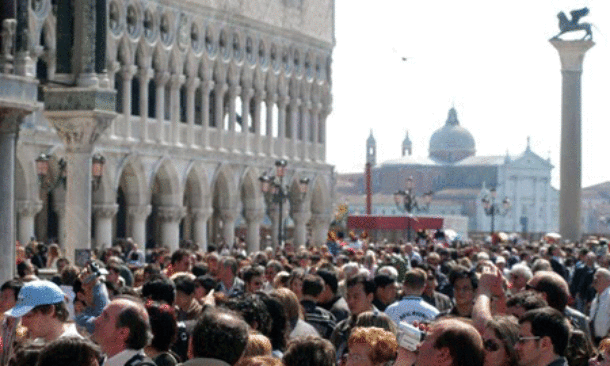Venice, La Serenissima, welcomes 25 million visitors annually to its living room, Piazza San Marco. That figure may be inching up to 30 million this summer. Tourism executives estimate that of those figures, 10 million stay overnight and the other 15 million spend the day in Venice tramping over its most ancient streets and sites. More than 100,000 people attended a recent firework organized to accommodate just 60,000.
You have heard this before, but tourism executives may have a plan in place to protect this corner of the world shortly. Venice is really smaller than you might imagine – about three square miles. It is composed of ancient buildings separated by 182 canals on 126 tiny islands linked by 435 bridges not to mention an infinite number of tiny alleys and streets. More than 600 big ships pass through the Giudecca Canal each year, one of the most delicate portions of Venice. In 2014, a motion was made to ban the large cruise ships from St. Mark’s and the Grand Canal, and allow only those under 960 tons to dock in the Venice lagoon, but the ruling was overturned.

The perennial discussion continues: Venice registers up to 30,000 cruise ship passengers each day during peak season. At the same time, the number of Venetians living in its historic center has been reduced to about 55,000 down from 164,000 in 1931. These numbers include the populations on Murano, Burano and the Lido so other reports indicate the historic center counts just 27,000 inhabitans.
To ease the effects of tourism on its locals, the city council introduced separate lines for tourists and locals at particular vaporetto stops (Venetians need to get to work even though tourists may be on vacation and the city is profiting from those visits). Then there was talk about banning wheeled suitcases from the city, but this concept was relinquished almost as soon as it was suggested. Recent reports in La Gazzetta Venezia indicated the city council was considering a ticketing system for the main square and other attractions, but Paola Mar, the Councillor for Tourism put that rumor to rest in a recent exchange with La Voce di New York.

An edited version of the exchange follows below:
If the city council has rejected the ticketing system, is there another plan?
“We are considering a reservation system that will include incentives such as discounts on museum tickets, local services, transportation and the use of public facilities to encourage people to visit Venice in the off-season. The new reservation system will employ online channels and social networks and could be in place as early as this year.”
Locals have been protesting the impact of tourism by large cruise ships in particular. Can you address this issue?
“Large cruise ships have an environmental impact on the city, but they also bring 1.5-1.7 million visitors to to Venice each year (yet just 60% stay overnight). The City Government has proposed an alternate route for the large cruise ships that would avoid the most delicate parts of the city — St. Mark’s Square and along the Giudecca Canal but we are waiting for the Italian Governement to make a final decision on the new route that should be followed to enter the Port (Marittima).”
According to one report, the city council approved plans – proposed by mayor Luigi Brugnaro and Counsel for Tourism Paola Mar – to effect the changes as quickly as possible.
“After an overall resolution about tourism governance was passed April 27th, there are 35 executive resolutions that must also be passed and implemented between 2017 and 2019, according to a scheduled action plan.”
Can you tell us about any particular plans within that strategy?
“The City Government wants and needs to know more precisely how many people actually come to town a year: this is why there will be counters registering the number of arrivals.”
How do you see this working?
“At first, the counters will register the number of arrivals at the most popular sites, share the figures on the city’s website in real time to discourage visitors rather than simply capping the numbers given admission to places such as Piazza San Marco and the Doge’s Palace to name two. “Tourism Bulletin” is to be dispatched on peak days/periods, in order to generally inform people that visiting conditions are critical and to discourage daytrippers, in particular.”

Where would the counters be placed?
“So far, that list includes the Riva degli Schiavoni (the waterside promenade which ends at Piazza San Marco), and bridges leading away from the railway station and Piazzale Roma, the terminus for the mainland.”
Last year the city received a warning from UNESCO that unless some action is taken, the city will find itself on the black list of endangered heritages sites, along with 38 other locations mainly in Africa and Asia.
“Delegation from the City Government, headed by the Lord Mayor Luigi Brugnaro, went to Paris at the end of January 2017, together with representatives from the Mibact (Italian Ministery for Cultural Heritage), and presented a significant report that shows what has been done so far and the actions that must be undertaken from now on.”
What are the new maps being designed for?
“The maps are created to draw visitors to lesser-known sites in La Serenissima, to encourage tourists to spread out to further alleviate the stress on the city’s most visited attractions. My advice to visitors is this: The best way to visit Venice is to get lost in the calli (small streets) and discover what’s beyond the iconic sites.”











